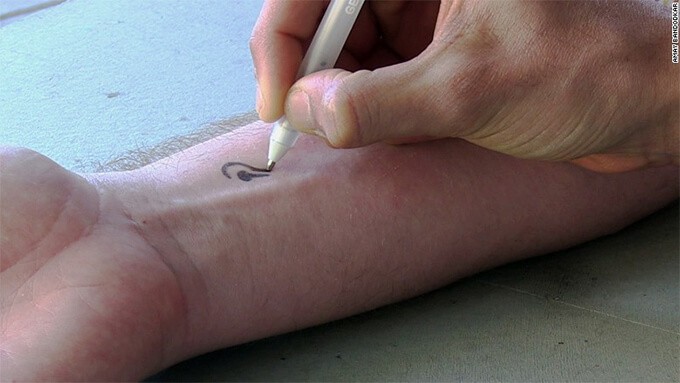Nano-engineers from the University of California, San Diego have developed bio-inks that can turn regular ballpoint pens into chemical sensors.
Among other things, people can measure glucose levels simply by drawing on skin with the engineered ink. According to CNN Money, it works like this:

Image Credit CNN
When drawn on the body, the ink adheres much like a temporary tattoo. It can detect things like the amounts of sodium insulate, lactate and glucose in your sweat. To read the measurements, the group is creating an electric Bluetooth-enabled device that will take the info from the drawn-on sensor and transfer it to a smartphone or laptop.
The ink also is able to detect pollutants on the leaves of plants, and researchers hope eventually to be able to use the bio-ink pens to test for everything from toxic gas to explosives, the university reports.
The really cool thing here is that the researchers, led by Dr. Joseph Wang, simply went out and bought cheap ballpoint pens, then refilled them with their bio-ink to conduct these tests.
I was a mediocre science student, at best, so I’m not even going to pretend to understand how exactly this happens. But for those of you who might understand it, the university explained the make-up of the bio-ink.
The biggest challenge the researchers faced was making inks from chemicals and biochemicals that aren’t harmful to humans or plants; could function as the sensors’ electrodes; and retain their properties over long periods in storage and in various conditions.
Researchers turned to biocompatible polyethylene glycol, which is used in several drug delivery applications, as a binder. To make the inks conductive to electric current they used graphite powder. They also added chitosan, an antibacterial agent which is used in bandages to reduce bleeding, to make sure the ink adhered to any surfaces it was used on.
The inks’ recipe also includes xylitol, a sugar substitute, which helps stabilize enzymes that react with several chemicals the do-it-yourself sensors are designed to monitor.
Ok, get all that?
One thing I did understand: Bio-ink pens designed to measure glucose could replace diabetic testing strips. According to UC – San Diego, one pen could equal as many as 500 of the expensive strips that diabetics now use several times a day.
One thing I wonder: Since they can use regular pen bodies for this bio-ink, could we eventually recycle used ink pens for this purpose?